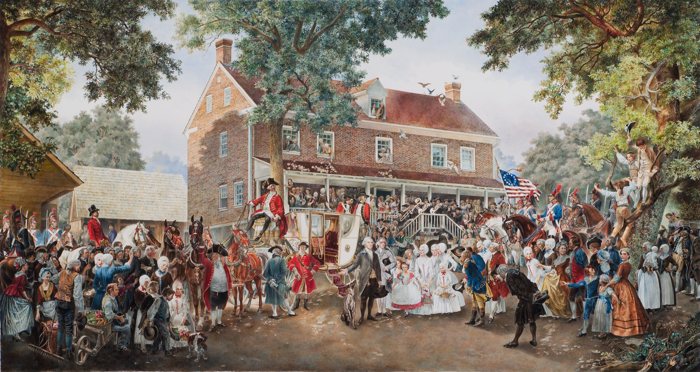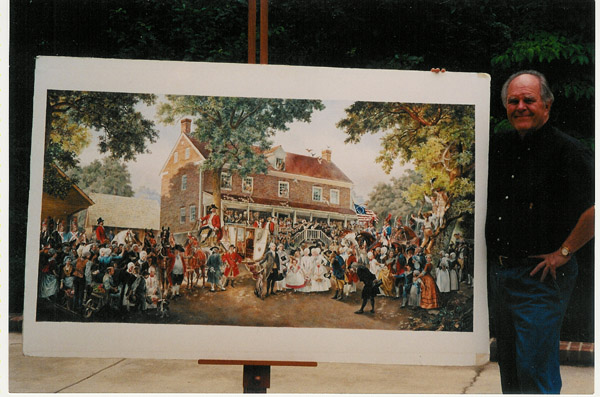By Werner Willis


Limited Edition Giclee Canvas of 100 size 69 5/8″ X 37 1/4″
Limited Edition Giclee Canvas of 350 size 42″ X 22 1/2″
Open Paper Lithograph size 20″ X 10 3/4″
Washington’s Southern Tour, May 31, 1791
Old Salem, North Carolina
President George Washington was at the end of his Southern tour when he arrived at the North Carolina village of Old Salem. His first impression as he approached the Moravian village was how pleasantly it was placed on rising ground surrounded by beautiful meadows, well-cultivated fields, and shady woods. The houses were built in a German style with trees surrounding them forming a pastoral scene.
To avoid giving out or owing political favors, Washington declined private offers of food and lodging and always looked for public accommodations wherever possible. He was impressed by the cleanliness and neatness of the Salem Tavern, and as he approached, he was greeted by music from the tavern steps. The Moravian band was an important tradition, but the Moravian practice of not calling attention to or exalting individuals was evident by the absence of festive decorations. Washington rarely smiled because of ill-fitting false teeth, but he wrote in his journal how much he enjoyed his Salem visit.
Major William Jackson, who had political connections in South Carolina, was Washington’s private secretary and traveling companion. They were accompanied by Washington’s pet greyhound, Cornwallis, and his white parade horse, Prescott. Washington, dressed in his continental uniform, rode Prescott into all the southern towns except Old Salem. In respect of their deep religious convictions, he entered by coach, dressed in civilian clothes, and had Prescott led by a groomsman.
Although smaller than his official state coach, Washington called this traveling coach “his white chariot”. The white coach was easily seen and recognizable from a great distance. The oval presidential seal, designed by Washington and used today, was painted on each of the four quarter panels. The four seasons, by Italian artist Cypriani, were painted on the doors, front and back of the coach. Washington would have preferred six cream-colored horses with white manes, but was warned that they would be a great disadvantage in the red dirt he would encounter on his southern journey. Instead he chose four reddish-brown, black-maned bays.
Great crowds followed and gathered around the entourage to see the legendary commander. While the men dressed as all 18th century males, the Moravian ladies stood out in the crowds by their unique dress. Work dresses were solid blue or brown, and a cap that covered all signs of hair was worn indoors and out. The caps and better dresses were always white. The ribbons that tied the cap and laced the jacket of the dress were colored according to the status of the woman. Little girls wore bright red, single women wore pink, married women blue, and widows wore white.
Charles Caldwell, one of the thirteen-rider escort formed in Salisbury, is the standard-bearer on the white horse. The thirteen riders represented the thirteen colonies. Caldwell and his company met Washington at the Waxaws to guide and inform him of the land, the people, and historic events of North Carolina. They traveled with him to the border of Virginia as Washington returned to his home at Mount Vernon.
Portrait of Washington taken from original painting by Gilbert Stuart
Portrait of Jackson from the Pennsylvania Magazine of History Engraving